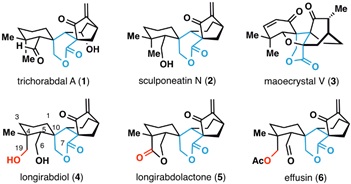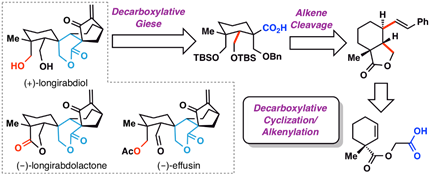On May 15, 2019- Dr. Chao Li’s laboratory (http://www.lichaolab.com/) reported the first total syntheses of C19 oxygenated spiro-lactoneent-kauranoids. The work entitled “Tandem Decarboxylative Cyclization/Alkenylation Strategy for Total Syntheses of (+)-Longirabdiol, (-)-longirabdolactone, and (-)-effusin” is published online in theJournal of the American Chemical Society(doi: 10.1021/jacs.9b03978, 2019, May 15. 2019). In this paper, a copper-catalyzed tandem decarboxylative cyclization/alkenylation sequence was developed and used in the total syntheses ofent-kauranoid successfully.
ent-Kauranes, a family of structurally diverse diterpenoids isolated from theIsodongenus, possess a broad spectrum of biological activities. The parent plants of such natural products have been used in traditional Chinese medicine for thousands of years, such asRabdosia rubescens. Particularly, spiro-lactone typeent-kauranoids, an important subclass ofent-kaurenes, have attracted extensive interest in thechemistry community owing to their mesmerizing architecture. However, construction of highly oxidized members of such diterpenoids presents considerable challenges in organic synthesis, and few syntheses of C19 oxygenated spiro-lactone typeent-kauranoid—possessing an intriguing quaternary stereocenter at C4—have been demonstrated to date.

Figure 1.Spiro-lactone typeent-Kauranes
In this study, researchers initially developed a Cu-catalyzed tandem decarboxylative cyclization/alkenylation sequence: a keycis-lactone intermediate with high complexity and multiple chiral centers was obtained in one pot from a stable and easily prepared material. In this process, the researchers found apivotaladditive—2-bromopropionic acid—could bolster the yield of the formation of highly strained g-lactone. The ring strain might be induced by the quaternary carbon at C4. Further studies on the substrate scope and mechanism revealed that this synthetic method possessedcommendablepracticability and could serve as a fine strategy for the construction ofent-kauranes with higher oxidative state.

Figure 2.Synthetic strategy of C19 oxygenated spiro-lactoneent-kauranoids
Based on the above newly devised transformation, further study disclosed that the spiro-d-valerolactone moiety could be synthesizedstereoselectively via a Ni-catalyzed decarboxylative Giese reaction, and 6/6 ring system could be constructed through oxidation, Michael addition, and RCM reactions. In the late stage of the total synthesis, the researchers adopted a traditional alkenyl radical addition to forge the bicyclo[3.2.1]octane ring system, and the first natural product, longirabdiol, was obtained through simple oxidation and deprotection. Using longirabdiol as starting material, longirabdolactone and effusin were provided via regioselective oxidations of C19 and C6 respectively. Furthermore, the researchers also found that these synthetic natural products displayed broad antitumor activity.
In summary, this study not only completed the first asymmetric total syntheses of three C19 oxygenated spiro-lactoneent-kauranoids, but also pave the way for further biological study. Of particular note is an in-house developed Cu-catalyzedtandem decarboxylative cyclization/alkenylation sequence which provide a useful strategy for the synthesis of other complex molecules, including natural products.
Jianpeng Zhang and Zijian Li (2019 PTN project) from Dr. Chao Li’s laboratory are the co-first authors of this paper.Other contributors include Junming Zhuo (Dr. Chao Li’s laboratory), Yue Cui (Dr. Ting Han’s laboratory), and Dr. Ting Han. Dr. Chao Li is the corresponding author. The study was supported by Beijing Municipal Science & Technology Commission, Tsinghua University, and MOST of China. This research work was carried out at National Institute of Biological Sciences, Beijing.